![]()
![]()
![]()
Use LEFT and RIGHT arrow keys to navigate between flashcards;
Use UP and DOWN arrow keys to flip the card;
H to show hint;
A reads text to speech;
46 Cards in this Set
- Front
- Back
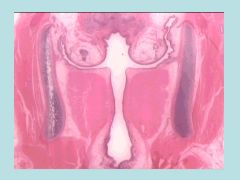
|
The Larynx - Laryngeal Ventricles, False Vocal Cords with glands, True Vocal Cords without glands, Vocalis Muscles, Glandular Epithelium (stratified squamous nonkeratinized epithelium). This is a coronal section through the Larynx. The white tunnels are known as the Laryngeal Ventricles. The two circular objects are known as the False Vocal Cords. Beneath them in dark pink are the True Vocal Cords with the vocalis muscles. Note the significant amount of glandular epithelium associated with both of them.
|
|
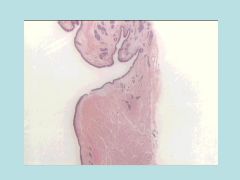
|
Larynx - Laryngeal Ventricle, False Vocal Cord, Glandular Epithelium, True Vocal Cord, Skeletal Muscle, PCCE, Stratified Squalmous Nonkeratinized Epithelium. This is a hemisection of the Larynx. The large white incursion is the laryngeal ventricle. The largest hump is the False Vocal Cord and the basophilic parts (dark purple spots) are the glandular epithelium. Beneath the False Vocal Cord, across the laryngeal ventricle, is the True Vocal Cord with evidence of white skeletal muscle. The dark purple epithelium outline of the larynx is composed of PCCE. There is a place on the True Vocal Cords where it transitions into stratified squamous nonkeratinized epithelium for protection from friction (thickness doubles). Note where the PCCE transitions into stratified squamous nonkeratinized epithelium and back into PCCE again.
|
|
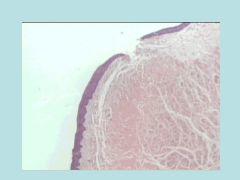
|
Larynx - PCCE transitioning into Stratified Squamous Nonkeratinized Epithelium. Again, note where the smooth PCCE transitions into stratified squamous nonkeratinized epithelium (rough underlying ridges).
|
|
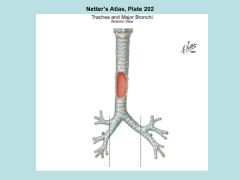
|
Trachea - Rings of Hyaline Cartilage - Note how the trachea is reinforced by dark rings of hyaline cartilage. They do not form a complete ring, but are more of an almost-closed "C" shape. The purpose of the Hyaline Cartilage is to prevent the trachea from collapsing from the negative pressure associated with inhalation. The opening is for the esophagus and swallowing.
|
|
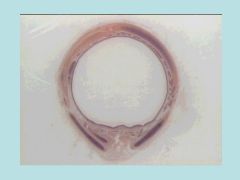
|
Trachea - Rings of Hyaline Cartilage - Note how the trachea is reinforced by dark rings of hyaline cartilage. They do not form a complete ring, but are more of an almost-closed "C" shape. The purpose of the Hyaline Cartilage is to prevent the trachea from collapsing from the negative pressure associated with inhalation. The opening is for the esophagus and swallowing.
|
|
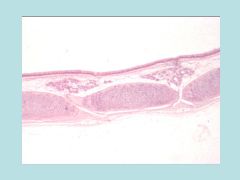
|
Trachea - Epithelium, Glandular Tissue, Cartilaginous Rings
|
|

|
Epithelium of Trachea - PCCE (Pseudostratified Ciliated Columnar Epithelium), Cilia
|
|
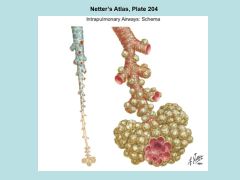
|
Bronchi with Hyaline Cartilage, Bronchioles without Hyaline Cartilage, End of Terminal Bronchiole/Conducting Passages, Alveoli, Respiratory Bronchioles, Respiratory Duct/Alveolar Duct, Alveolar Sac - If there is hyaline cartilage visible, we call them bronchus/bronchi. If there is no hyaline cartilage visible, we call them Bronchioles. When bronchioles begin to have alveoli, then they are referred to as respiratory bronchioles. When the respiratory bronchioles are absolutely covered in alveoli, then we call it a Respiratory/Alveolar Duct. A huge cluster of alveoli at the end an Alveolar Duct is referred to as an Alveolar Sac.
|
|
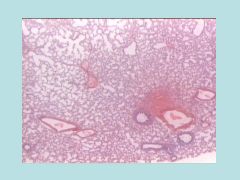
|
Lung - Blood Vessels, Bronchi, Air Spaces - Low magnification view of the Lung. Note the empty spaces for the air to pass through. The red blobs are blood vessels. The striped purple circles are bronchi.
|
|
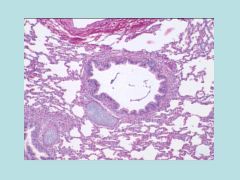
|
Lung - Bronchus, Hyaline Cartilage plate - Cross section of a bronchus. The lighter purple plate is a plate of Hyaline cartilage.
|
|

|
Lung - Bronchiole (note lack of Hyaline Cartilage)
|
|
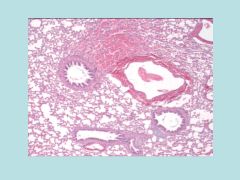
|
Lung - 3 Bronchi with 3 Small Plates of Hyaline Cartilage, Ruptured Blood Vessel
|
|
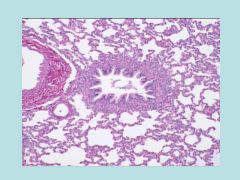
|
Lung - Bronchiole (note lack of Hyaline Cartilage)
|
|

|
Lung - Terminal Bronchiole, Respiratory Bronchiole, Alveoli, Simple Columnar Epithelium, Simple Cuboidal Epithelium. The circular white spaces are alveoli. The terminal bronchiole does not have any alveoli attached to its wall. The respiratory bronchiole is beginning to have alveoli attached (such as the three "half circles" - the other half of them simply didn't show up...it's there). Also, note how the epithelium changes from simple columnar to simple cuboidal.
|
|
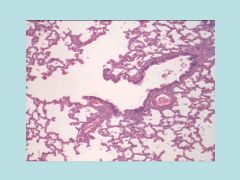
|
Lung - Terminal Bronchiole with thicker simple columnar epithelium branching into two respiratory bronchioles with thin simple cuboidal epithelium.
|
|

|
Lung - Respiratory Bronchioles, Respiratory Ducts, Alveoli, Alveolar Sacs. Respiratory Bronchioles becoming Respiratory Ducts with walls of mostly alveoli. You know they are Respiratory Ducts because they terminate into clusters of alveoli called alveolar sacs.
|
|
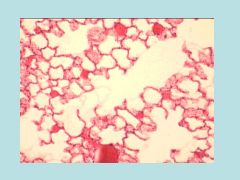
|
Lung - Respiratory Duct, Alveolar Sacs. Respiratory Ducts becoming Alveolar Sacs.
|
|
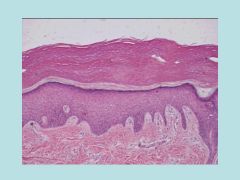
|
Thick Skin (because of its thick epidermal layer) - Epidermis, Dermis, Stratified Squamous Keratinized Epithelium, Dense Regular Connective Tissue, BSGLC Stratum Basale, Stratum Spinosum, Stratum Granulosum, Stratum Lucidum, Stratum Corneum - Epidermis, composed of stratified squamous keratinized epithelium and the Dermis, the lighter purple containing dense regular connective tissue. The lowest layer of epidermal tissue adjacent to the dermis is called the stratum basale. The next layer with far less basophilic staining is called the stratum spinosum. The dark purple line on top of this layer is called the stratum granulosum - it is the last layer of living cells. The white layer is called the stratum lucidum. It is only in thick skin and the easiest way to tell you're looking at thick skin. The final, top layer is the thick stratum corneum layer.
|
|
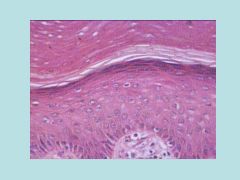
|
Thick Skin under Higher Magnification - BSGLC Stratum Basale, Stratum Spinosum, Stratum Granulosum, Stratum Lucidum, Stratum Corneum
|
|
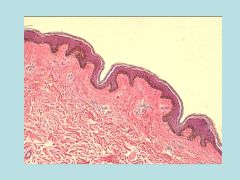
|
Thin skin - BSGC Stratum Basale, Stratum Spinosum, Stratum Granulosum, Stratum Corneum (No Stratum Lucidum), Keratinocytes, Melanocytes, papillary dermis, reticular dermis, papilae -
Stratum Basale (brownish because of melanin), Stratum Spinosum, Stratum Granulosum, Stratum Corneum (No Stratum Lucidum), Keratinocytes (cells found everywhere in skin) and Melanocytes (only in stratum basale - the blue&white scattered dots). Also note the two parts of the Dermis - the papillary dermis and the reticular dermis. The top layer has many extensions called papilae, giving the papillary dermis layer its name. |
|
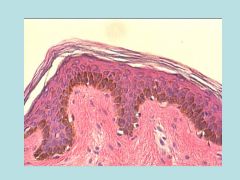
|
Thin skin - BSGC Stratum Basale, Stratum Spinosum, Stratum Granulosum, Stratum Corneum (No Stratum Lucidum), Keratinocytes, Melanocytes, papillary dermis, papilae
|
|
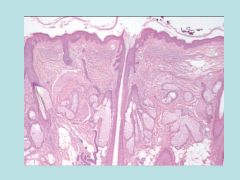
|
Scalp - Dark purple Hair Follicle (white shaft is where the hair once was), Lighter purple exocrine glands called sebacous glands that secrete sebum.
|
|
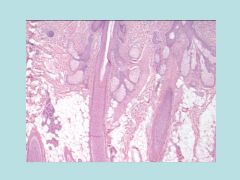
|
Scalp - pili arrector muscles, reticular dermis, hypodermis, adipocytes - Pili arrector muscles (smooth light purple extension). They are innervated by the sympathetic nervous system only, so when you are excited, these muscles are what cause your hair to stand on end. You can also note the purple reticular dermis meeting the white hypodermis with adipocytes.
|
|
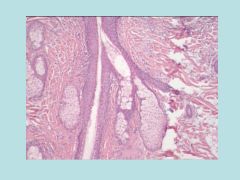
|
Hair Follicle in Higher Magnification - Hair Follicle, Sebacous Glands
|
|
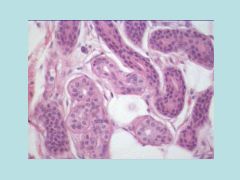
|
Eccrine Sweat Gland - Secretory Cells, Simple Cuboidal Cells, Duct Cells, Stratified Cuboidal Cells - Secretory Cells (Coiled Purple Portions with round nuclei - simple cuboidal cells), Duct Cells (Long Purple Portions with elongated stratified nuclei - stratified cuboidal cells)
|
|
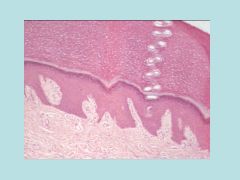
|
Integument Epithelium - Note the white spots where the duct of the sweat gland coils through the epithelium to reach the surface.
|
|
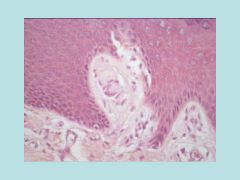
|
Encapsulated Nerve Ending in Integument - Meissner's Corpuscle. They are located in the Dermal Papillary regions in order to detect touch.
|
|
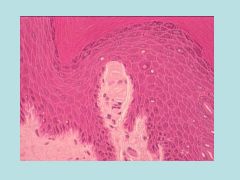
|
Encapsulated Nerve Ending in Integument #2 - Meissner's Corpuscle. They are located in the Dermal Papillary regions in order to detect touch.
|
|

|
Pacinian corpuscles in the Reticular Dermis (much larger than the Meissner's corpuscle). They look like an onion that has been sliced in half. They sense vibration and deep touch/pressure.
|
|
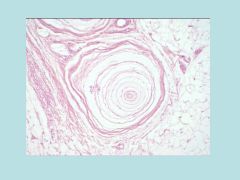
|
Pacinian corpuscles in the Reticular Dermis under a higher magnification.
|
|
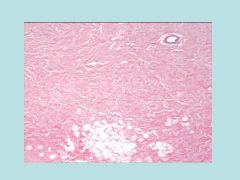
|
Inactive Mammary Gland from a woman who is not pregnant - Inactive gland that is composed of mostly of adipose tissue, dense irregular connective tissue, collagen fibers, one white secretory duct is visible.
|
|
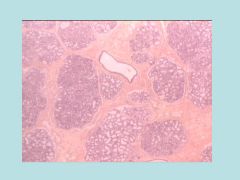
|
Active Mammary Gland of a pregnant woman - Note the growth of the glandular epithelium, abundant secretory structures and the large white secretory duct.
|
|
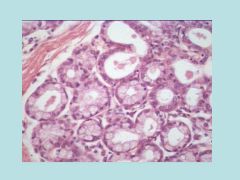
|
Glandular Epithelium of an Active Mammary Gland - Distinguish between the white ducts and the pale purple secretory portions of the epithelium.
|
|

|
Pituitary Gland - adenohypophysis, pars distalis, pars intermedia, pars tuberalis, neurohypophysis, infundibulum, pars nervosa. - The dark purple section is called the adenohypophysis. The center of this portion is called the pars distalis. The outer portion along the border is called the pars intermedia. The upper portion that resembles a tube is called the pars tuberalis. The lighter purple section is called the neurohypophysis, containing large numbers of neural axons. The funnel-shaped, top portion is called the infundibulum. The body portion is referred to as the pars nervosa.
|
|
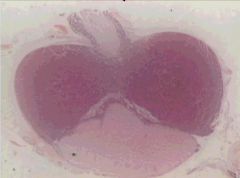
|
Pituitary Gland - adenohypophysis, pars distalis, pars intermedia, pars tuberalis, neurohypophysis, infundibulum, pars nervosa. The lightest purple at the top is the infundibulum surrounded by the pars tuberalis. The darkest purple is pars distalis, followed by the lighter pars intermedia underneath it and then pars nervosa.
|
|
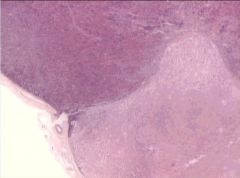
|
Pituitary Gland - pars distalis, pars intermedia, pars nervosa - Higher magnification view of the pars distalis, followed by the lighter pars intermedia underneath it and then pars nervosa.
|
|
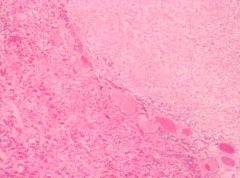
|
Pituitary Gland - pars distalis, pars intermedia, Rathke's pouch structures, pars nervosa - Even higher magnification, to the left is the clumpy pars distalis and the pars nervosa to the right. Between the two is the pars intermedia with the presence of Rathke’s pouch structures.
|
|

|
Thyroid Gland - follicles, colloid - Only endocrine gland to store its secretions, they are stored in the bubbles called follicles and contain colloid - the precursor to thyroid hormones.
|
|

|
Thyroid Gland - follicles, simple cuboidal epithelium, collagen, parafollicular cells, calcitonin - epithelium of the follicles is composed of simple cuboidal epithelium. In between the follicles is a lot of collagen. Also in between the follicles are clusters of Parafollicular cells. They secrete a hormone called calcitonin.
|
|
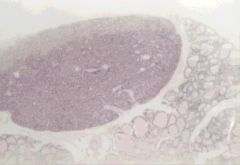
|
Parathyroid Gland - Most people have between 4-8 parathyroid glands. They are located on the posterior of the thyroid gland. Secretes parathyroid hormone which stimulates osteoclasts to become active and release calcium into the blood.
|
|
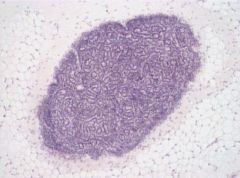
|
Parathyroid gland - notice the cords of cells within it
|
|
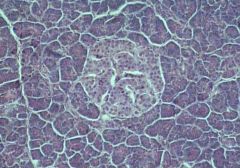
|
Pancreas - endocrine cells called islets of Langerhans - the lighter portion in the center is endocrine in function... a mass of endocrine cells embedded in exocrine glands called islets of Langerhans, which regulate blood sugar levels with insulin and glucogen.
|
|
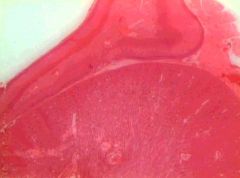
|
Adrenal Gland sitting on top of the Kidney - sometimes referred to as the suprarenal gland because of its location on top of the kidneys.
|
|
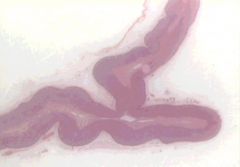
|
Adrenal Gland - Medulla, Cortex - Note the two functional divisions: the light purple is the medulla, the dark purple is the cortex.
|
|
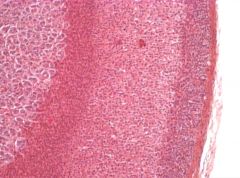
|
Adrenal Gland - Medulla, Cortex - Higher magnification view. Note the two functional divisions: the white outlined cells of the medulla, the multicolored cortex, and an outer layer of connective tissue. The multicolored, multilayered cortex from the outside-in are: zona glomerulosa, zona fasciculata, zona reticularis.
|
|
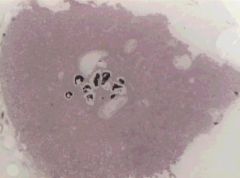
|
Pineal Gland - Secretes melatonin. Note the dark crystalline structures called Brain Sand, representing the accumulation of calcium deposits over time.
|

